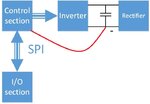kappa_am
Full Member level 6
Hi All,
I have designed a power electronic inverter. the DC link is supplied by single phase grid by a diode bridge. The control section is supplied by an isolated DC link. The problem is that when I connect negative bus of the DC link to the GND (isolated from the grid) of the control board's power supply, the SPI communication between the control board and IO board is failed. Following block diagram shows the whole system.
**broken link removed**
I measured the voltage of the mid of the DC link with respect to control board's power supply; it is like below picture:
**broken link removed**
When I connect the negative bus of the DC link to the GND of the control board, at the beginning, there is a small spark but not considerable current flows ( I have 100mA fuse in the path).
When I disconnect the rectifier from the grid ( DC link is still charged) the midpoint voltage becomes flat zero (as it should be). The midpoint sway when the rectifier's diodes are conducting.
I wonder where is the problem? What is the solution? what about connecting a capacitor between system ground and GND of control section's power supply?
Furthermore, two of my microcontroller programmers failed in a month ( after several programming). I think it may be because of this ground problem.
I would be greatly thankful if you help me with this problem and share your comments.
I have designed a power electronic inverter. the DC link is supplied by single phase grid by a diode bridge. The control section is supplied by an isolated DC link. The problem is that when I connect negative bus of the DC link to the GND (isolated from the grid) of the control board's power supply, the SPI communication between the control board and IO board is failed. Following block diagram shows the whole system.
**broken link removed**
I measured the voltage of the mid of the DC link with respect to control board's power supply; it is like below picture:
**broken link removed**
When I connect the negative bus of the DC link to the GND of the control board, at the beginning, there is a small spark but not considerable current flows ( I have 100mA fuse in the path).
When I disconnect the rectifier from the grid ( DC link is still charged) the midpoint voltage becomes flat zero (as it should be). The midpoint sway when the rectifier's diodes are conducting.
I wonder where is the problem? What is the solution? what about connecting a capacitor between system ground and GND of control section's power supply?
Furthermore, two of my microcontroller programmers failed in a month ( after several programming). I think it may be because of this ground problem.
I would be greatly thankful if you help me with this problem and share your comments.

